JDS Labs has built a solid reputation for consistently delivering high-performing, elegantly designed gear—and the Element and Atom series are prime examples. Over the years, these lines have earned praise for their clean aesthetics and flawless audio quality.
Now in its fourth generation, the new JDS Labs Element IV brings more power and added functionality to the table. But with a higher price tag of $549, the big question is: does it offer enough to justify the upgrade? We spent time with this made-in-USA DAC/Amp to find out if it’s truly a step forward—or just more of the same.
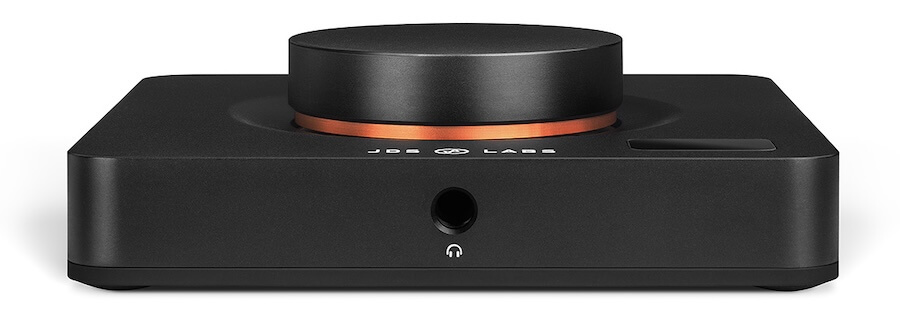
Specifications & Technology
Delivering 3.2 watts of power (10.2Vrms) into 32-ohm headphones, the Element IV marks a significant performance leap over its predecessor—the Element III—which maxed out at just 2.3 watts in boost mode.
JDS Labs also claims perfect channel balance down to -127.5 dBFS, along with measurable improvements across the board: SINAD hits 118 dB at 1kHz, THD+N drops below 0.00025%, and SNR climbs to an impressive 120 dB.
On the digital side, the Element IV supports 32-bit/384kHz PCM, DSD128, and ASIO playback—courtesy of its third-generation XMOS XU316 processor. It features the ESS Sabre ES9018K2M DAC, which, while not the flagship chip in ESS’s lineup, has been expertly tuned in-house by JDS Labs and remains a trusted component across many of their well-regarded products.
Auto-gain, a surprisingly useful feature that removes the necessity of toggling between low and high gain modes manually, has remained on the Element IV. Same with relay muting, which prevents pops and bangs when starting up the device to protect any connected headphones. Independent processors inside the device also monitor the internals to keep connected speakers or headphones safe.
While the volume knob remains the centerpiece of the Element IV, it’s been taken to the next level with a second-generation discrete optical encoder. Rated for millions of turns, this new encoder features 50% more fins and upgraded optical sensors, ensuring smoother, more precise volume adjustments with every turn.
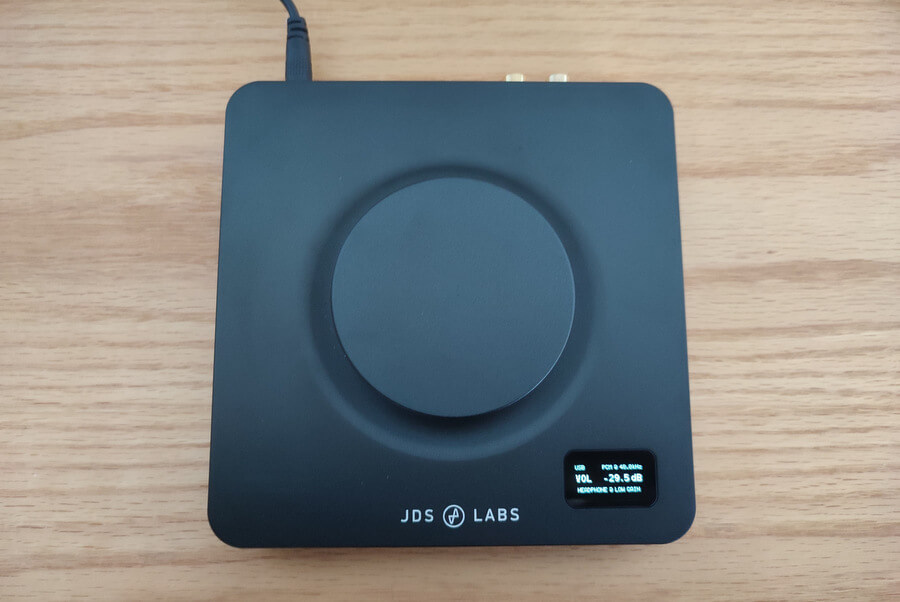
The Element IV is fully UAC2-compatible for high-performance audio, but it can also be switched to UAC1 mode, making it compatible with consoles like the Nintendo Switch and PlayStation PS5.
While the Element IV can’t be powered solely via USB-C, this design choice is aimed at minimizing signal noise for optimal audio performance. Instead, it uses an external AC transformer paired with 13 regulators to ensure a stable rail voltage, ultra-low ripple, and mains isolation.
The conversion stage is powered by a dedicated, ultra-low-noise LT3045 regulator—truly top-tier components for audiophile-grade sound and somewhat unusual at this price point.
Perhaps the most significant update is the inclusion of a ten-band parametric equalizer (PEQ), giving users the ability to fine-tune the frequency response directly through the JDS Labs Core web app. This level of Digital Signal Processing (DSP) is a rarity at this price point. Best of all, there’s no need to download additional software, and the interface is far more user-friendly than Peace EQ or other equalization tools.
According to the company, crossfeed and loudness compensation adjustments will be added to JDS Labs Core in future updates.
Design & Build
The JDS Labs Element IV arrives in a simple cardboard box, with a 17VAC 1.4A power supply and a one-meter USB-A to USB-C cable included. Personally, I’d prefer a USB-C to USB-C cable, as many modern devices no longer feature a USB-A port.
At the front of the Element IV, you’ll find only the quarter-inch headphone output. Moving to the top, there’s a bright OLED screen protected by Gorilla Glass, alongside a large volume knob with a customizable built-in button.
I couldn’t help but enjoy using the volume knob, sometimes just for fun. It allows for incredibly precise adjustments, with the default setting increasing or decreasing the volume by just 0.5dB per step.
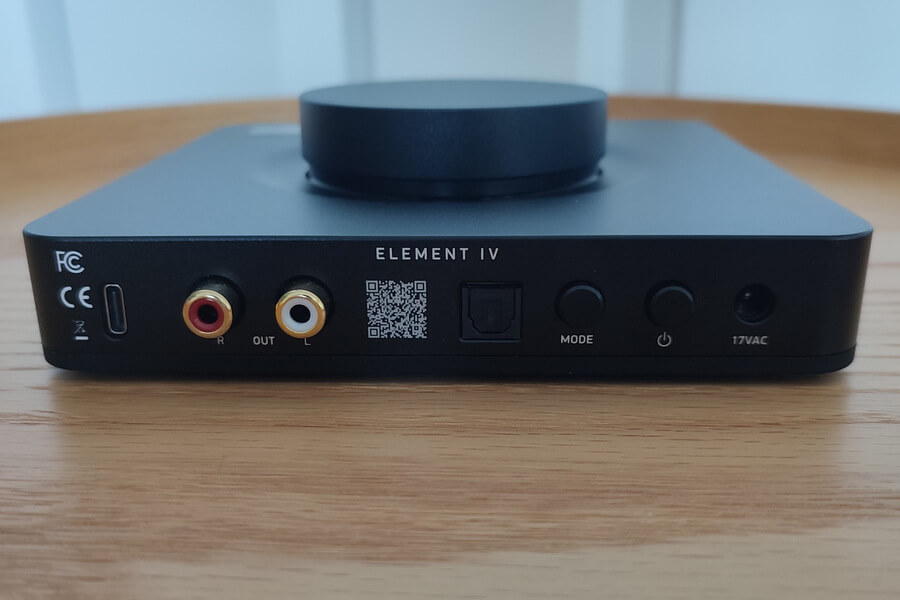
At the back, you’ll find the 17V socket for the AC transformer, the power on/off button, a switch to toggle between RCA and PO, optical TOSLINK, RCA L/R outputs, and a USB-C data input.
It’s worth mentioning that some physical aspects of the Element IV are customizable, provided you’re willing to reach out to their friendly customer service team. They offer options like swapping the quarter-inch output for a 4.4mm, engraving the volume knob with your choice of design, adding copper accents, or even replacing the metal knob with a clear resin one.
Beyond those customizations, the build quality is impressively solid, with a predominantly metal construction and bright LEDs encircling the volume knob. Its minimalistic design blends seamlessly, complementing any decor in your home or office space.
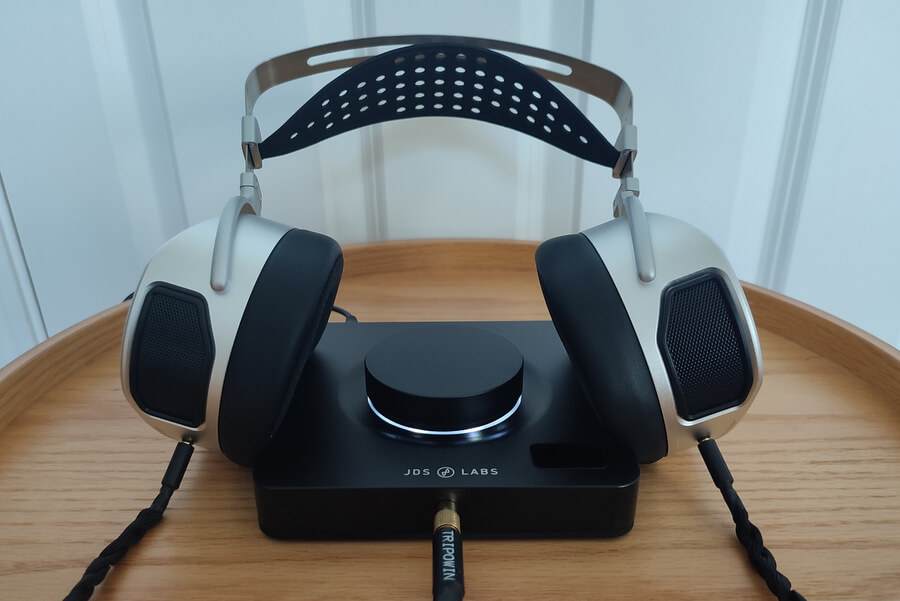
Performance & Synergy
To evaluate the sonic performance of the Element IV, I connected it to my laptop using the included USB-C to USB-A cable, playing a mix of hi-res FLAC files and Spotify streams.
With over 3 watts of power from the quarter-inch jack at 32 ohms, the JDS Labs Element IV proved more than powerful enough for all the over-ear headphones I tested, including the notoriously difficult-to-drive HiFiMAN HE6se V2. While my preferred listening volume sits around 65 to 70 decibels, even at -10dB on low gain, there was more than enough headroom for those who prefer higher volumes.
On the other end of the spectrum, I also tested the Moondrop Blessing 3 IEMs, which are highly sensitive to volume changes. Despite this, the Element IV powered them effortlessly, delivering a completely noiseless, black background.
In terms of frequency response, the JDS Labs DAC/Amp delivers a neutral sound signature, imparting no noticeable coloration to the audio. However, I found myself particularly drawn to the lower frequencies— the bass was rich, punchy, and full of dynamism.
Britney Spears‘ “Toxic“ is an excellent test track because it combines a wide range of sonic elements that challenge both the frequency response and clarity of headphones or audio gear. The track features sharp, intricate highs, a dynamic bassline, detailed midrange vocals, and layered synths, all of which require precise reproduction for an accurate listening experience.
Listening to the Audio-Technica ATH-R70x through the Element IV, I found the synthetic bass that runs throughout “Toxic” to have a noticeable impact, with solid texturing. It felt more pronounced compared to the similarly priced iFi GO bar Kensei, though the difference was minimal.
The midrange is both detailed and dynamic, maintaining an impressively linear response throughout. The treble is equally precise and clear, never veering into harshness.
Don’t expect the JDS Labs Element IV to dramatically alter your listening experience unless you’re utilizing the EQ functionality, especially if it’s your first time using an external DAC/Amp for your headphones. It won’t tame the spiky treble of Beyerdynamic DT990 Pros or add a bass boost to the Sennheiser HD600, for instance.
However, what it excels at is extracting the absolute maximum sonic performance from any device you plug into it—exactly what many audiophiles are looking for.
I also tested the Element IV as a standalone DAC, connecting it to the Aune S17 Pro amplifier via the rear RCA outputs. Since the DAC doesn’t impose its own color on the sound, it allowed the amplifier to shine.
The S17 Pro, a warm-sounding Class A amp, paired beautifully with the Element IV, resulting in a sound that was warm, spacious, and sweet, with a noticeable increase in overall resolution.
The UI for the JDS Labs Core web panel is truly excellent—clean and uncluttered, yet offering a wealth of options to tweak the sound, both for the headphone output and the RCA outs separately.
I appreciated the ability to save custom EQ profiles and switch between them, as well as import profiles from other Element IV users, Squiglink profiles, and local files. This level of functionality is often overlooked in DAC/Amps that cost thousands of dollars, making it a genuine benefit of the Element IV.
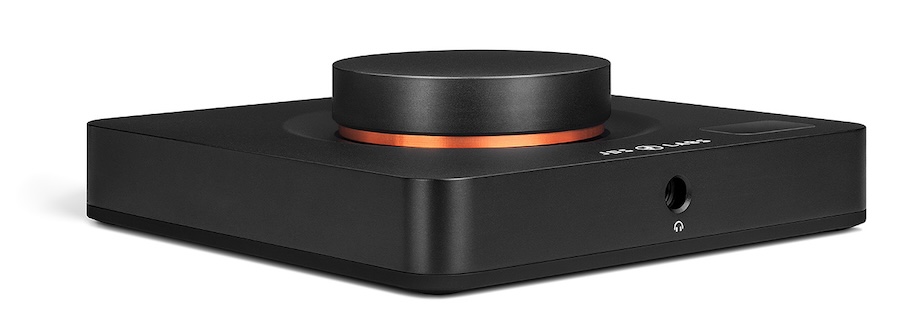
The Bottom Line
The JDS Labs Element IV DAC/Amp delivers exactly as promised. It’s a powerful all-in-one device capable of driving a wide range of headphones with ease. With its sleek design, high build quality in the United States, and built-in parametric equalizer functionality, it’s truly a standout product for its asking price. You could spend more with Schiit Audio and not get this level of refinement or adjustability.
Pros:
- The Element IV provides over 3 watts of power at 32 ohms, making it capable of driving even the most demanding headphones, like the HiFiMAN HE6se V2.
- It offers a transparent, neutral sound signature, allowing headphones and other connected devices to retain their natural characteristics without added coloration.
- Designed and built in the United States, the Element IV boasts a sleek, minimalistic design with robust metal construction, ensuring both aesthetics and durability.
- A standout feature is the built-in ten-band parametric equalizer, offering audiophiles the ability to fine-tune the frequency response, without requiring third-party software.
- The JDS Labs Core web app provides an intuitive interface for users to save custom EQ profiles, import profiles from other users, and switch between different sound settings.
- It includes USB-C data input, RCA outputs, optical TOSLINK, and supports both UAC2 and UAC1 for compatibility with a wide range of devices, including gaming consoles like the PS5 and Nintendo Switch.
- The Element IV provides a “black background” even when driving sensitive IEMs, ensuring that there’s no unwanted noise or distortion.
Cons:
- Unlike some modern devices, the Element IV can’t be powered solely via USB-C. It requires an external AC transformer, which, while improving signal integrity, may be seen as an inconvenience compared to more streamlined devices.
- The Element IV only offers a 1/4-inch headphone output. While this is suitable for most headphones, users with headphones requiring a 4.4mm balanced output may need to use an adapter or opt for a customized version.
- The Element IV does not have wireless connectivity options like Bluetooth, which might be a dealbreaker for users looking for a wireless solution in addition to its wired capabilities.
Where to buy:
Related Reading:





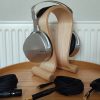

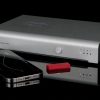
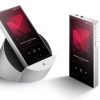

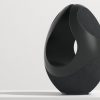
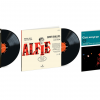
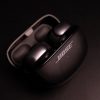

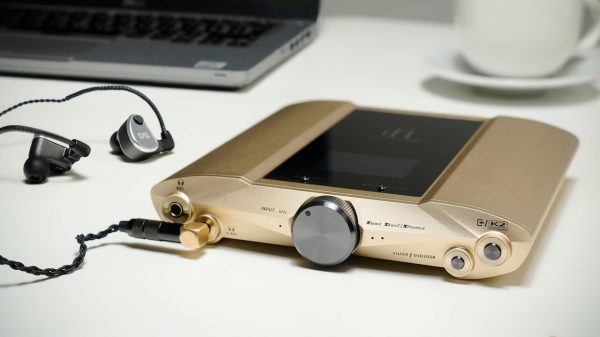
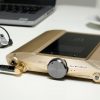


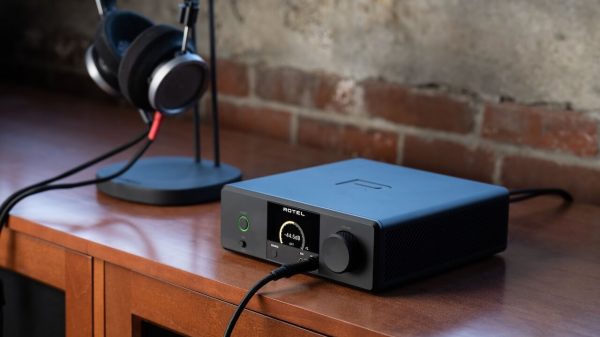
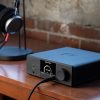
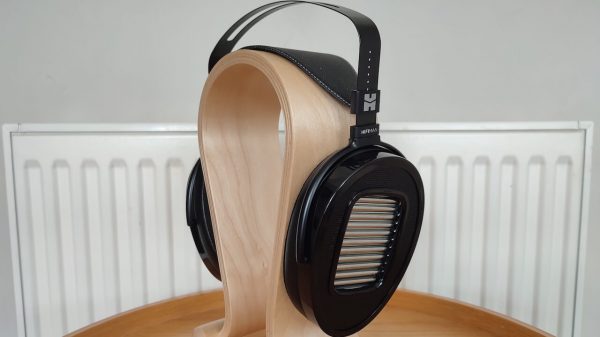















Antonio the Sorta Ok
April 5, 2025 at 5:59 pm
How does this compare to something in the same price range from Schiit Audio?
Excellent review and my interest is definitely piqued now.
Made in America and looks very expensive.
The Naim volume wheel has become a thing.